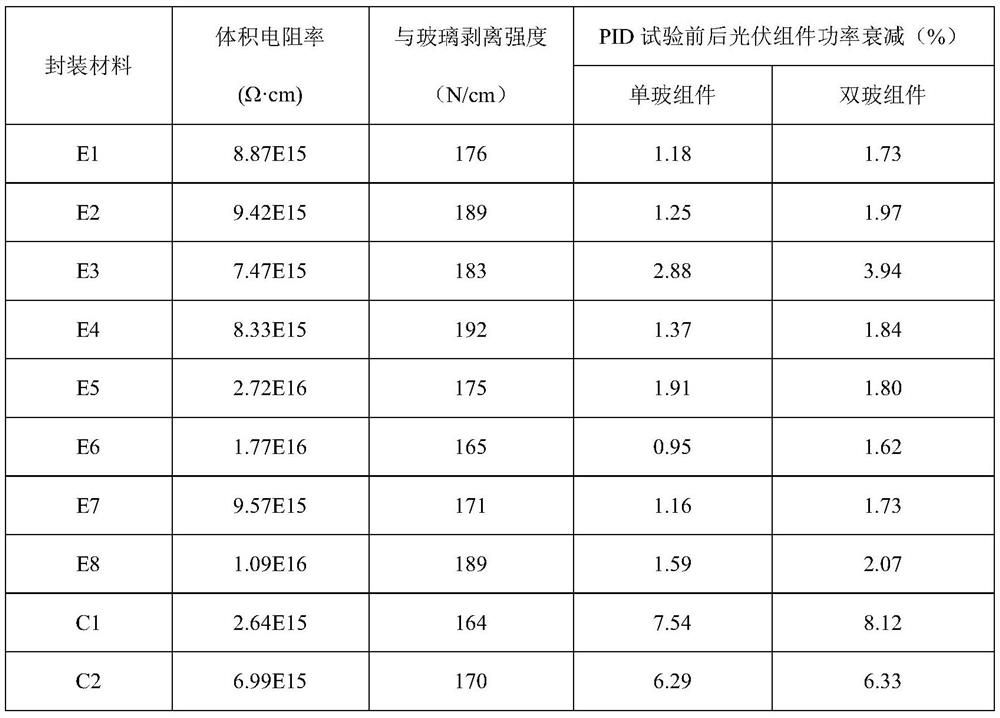A kind of anti-potential induced decay multilayer composite photovoltaic encapsulation film and preparation method and application
A potential-induced attenuation and multi-layer composite technology, which is applied in photovoltaic power generation, film/sheet adhesives, circuits, etc., can solve the problem of unsatisfactory anti-PID effect of double-sided cell modules, which is unfavorable for cost reduction of photovoltaic modules , high price of polyolefin resin raw materials, etc., to achieve the effect of enhancing the resistance to potential-induced attenuation, eliminating passivation, and lasting and stable anti-PID performance
- Summary
- Abstract
- Description
- Claims
- Application Information
AI Technical Summary
Problems solved by technology
Method used
Image
Examples
Embodiment 1
[0030] This embodiment provides a packaging material having anti-PID performance.
[0031] Bonding layer: Take 100 parts of the VA (vinyl acetate) by mass of 10 parts of VA (vinyl acetate) having a mass content of 21% by mass, add 0.8 parts of tert-butyl peroxide carbonate, 0.8 parts of three Alcohol dimethyl methacrylate, 0.1 parts of 2-hydroxy-4-orthodoxyxyl diphenyl ketone, 0.2 parts vinyl triethoxysilane, 0.1 part double (2, 2, 6, 6-tetra) 4-piperidinyl) sebacate.
[0032] Blocking layer: Take 100 parts by mass, 10 parts of ethylene-octene copolymer, 5 parts of polyethylene oxide, 0.5 parts of pentarate tetra-acrylate, 0.1 parts of 2,5-dimethyl 2, 5- Double (tert-butoxy) hexane, 0.1 parts of 2-hydroxy-4-orthodoxybenzophenone, 0.2 parts vinyl triethoxysilane, 0.1 parts (2, 2, 6, 6- Tetimol-4-piperidyl) sebacate.
[0033] Different extruders were added to the composition of the resin of the barrier layer and the auxiliary layer. The extrusion material of the binder layer, the ex...
Embodiment 2
[0037] This embodiment provides a packaging material having anti-PID performance.
[0038] Bonding layer: Take 100 parts of the VA (vinyl acetate) mass content of 26% by mass consolidation, 0.8 parts of tert-butyl peroxide carbonate, 10 parts of ethylenedioliol Tetracrylate, 0.4 parts 2- (2'-hydroxy-3 ', 5'-diophenylphenyl) benzotriazole, 3 parts of aminopropyl trisopropoxysilane, 1 double (2, 2) , 6,6-tetramethyl-4-piperidyl) sebacate.
[0039] Blocking layer: Take 100 parts of a mass fraction, 5 parts of a polyether ester amide, 0.5 parts of polyether ester amide, 0.5 parts of a polyether ester amide, 0.5 parts of triethylene glycol dimethyl acrylic acid Ester, 0.1 parts of 2,5-dimethyl 2,5-bis (tert-butoxy) hexane, 0.1 parts of 2-hydroxy-4-n-octyl diphenyl ketone, 0.2 parts of aminopropyl three Isopropoxysilane, 0.5 parts of bis (2,2,6,6-tetramethyl-4-piperidyl) sebacate.
[0040] After the multilayer coextrusion is formed, after cooling, the electronic radiation chamber is tra...
Embodiment 3
[0044] This embodiment provides a packaging material having anti-PID performance.
[0045] Adhesive layer 1: Take 100 parts of the VA (vinyl acetate) mass content with a mass fraction, a vinyl acetate copolymer having a mass content of 12%, adding 1 part of 2,5-dimethyl 2,5-double ( Tert-butoxyenoxy) hexane, 5 parts of ethylene hydroxymethyl propane trisyl acrylate, 1 parts of aminopropyltrimethoxysilane, 0.1 parts of 2-hydroxy-4-methoxybenzophenone, 0.1 Part 2 (2,2,6,6-tetramethyl-4-piperidyl) sebacate.
[0046] Barrier layer: Take 100 parts of the vinyl-butene copolymer graviz, 5 parts of methoxy polyethanol methacrylate copolymer, 0.5 Part of ethylene hydroxymethyl propane trisyl acrylate, 0.1 parts of 2,5-dimethyl 2,5-bis (tert-butoxy) hexane, 0.1 parts of 2-hydroxy-4-methoxy group Benzophenone, 0.2 parts of aminopropyltrimethoxysilane, 0.1 parts bis (2,2,6,6-tetramethyl-4-piperidyl) sebacate.
[0047] Adhesive layer 2: Take 100 parts of a VA (vinyl acetate) mass content of 10...
PUM
| Property | Measurement | Unit |
|---|---|---|
| thickness | aaaaa | aaaaa |
| thickness | aaaaa | aaaaa |
| thickness | aaaaa | aaaaa |
Abstract
Description
Claims
Application Information
 Login to View More
Login to View More - R&D
- Intellectual Property
- Life Sciences
- Materials
- Tech Scout
- Unparalleled Data Quality
- Higher Quality Content
- 60% Fewer Hallucinations
Browse by: Latest US Patents, China's latest patents, Technical Efficacy Thesaurus, Application Domain, Technology Topic, Popular Technical Reports.
© 2025 PatSnap. All rights reserved.Legal|Privacy policy|Modern Slavery Act Transparency Statement|Sitemap|About US| Contact US: help@patsnap.com

